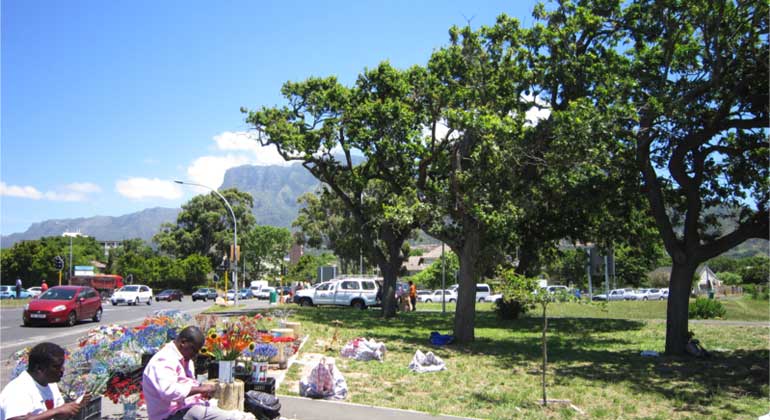Urban trees are growing faster worldwide
Trees in metropolitan areas have been growing faster than trees in rural areas worldwide since the 1960s. This has been confirmed for the first time by a study on the impact of the urban heat island effect on tree growth headed by the Technical University of Munich (TUM).
The analysis conducted by the international research team also shows that the growth of urban trees has already been exposed to changing climatic conditions for a long period of time, which is only just beginning to happen for trees in rural areas.
„While the effects of climate change on tree growth in forests have been extensively studied, there is little information available so far for urban trees“, said Professor Hans Pretzsch from the Chair for Forest Growth and Yield Science at TUM. The study supported by the Bavarian State Ministry for Environment and Consumer Protection as well as by the Audi Foundation for the Environment, which was published in the journal „Nature Scientific Reports“, for the first time systematically examined the growth of urban trees worldwide for trends resulting from changing environmental conditions.
A central motivation for Professor Pretzsch’s team is the prevailing trend towards global urbanization: According to calculations by the United Nations, the urban population worldwide is expected to increase by more than 60 percent by 2030 – with a continuing upward trend. Urban trees already improve the climate in cities and contribute to the well-being and health of city dwellers, and these forecasts show that their significance for the quality of life in cities will increase even further in the future.
Heartwood samples from the metropolises of Berlin, Brisbane, Cape Town, Hanoi, Houston, Munich, Paris, Prince George, Santiago de Chile, and Sapporo were collected and analyzed. The cities were selected to cover different climate zones. The spectrum ranged from boreal to temperate, Mediterranean, and subtropical climates. In total, the TUM research team focused on almost 1400 mostly mature trees. A typical and predominant tree species was selected for each city and examined in both the city center and surrounding rural areas.
Urban Trees Grow One Quarter Faster than Rural Trees
„We can show that urban trees of the same age are larger on average than rural trees because urban trees grow faster“, said Professor Pretzsch. Further observation showed that the relative difference in size between urban and rural trees decreases with increasing age, but still remains relevant. „While the difference amounts to about a quarter at the age of 50, it is still just under 20 percent at a hundred years of age.“
The researchers believe that the growth acceleration of urban trees is due to the so-called heat island effect. This effect leads to a stronger heating-up and thus higher temperatures in urban centers. Compared to the surrounding rural area, this increase in temperature can amount to between three and ten degrees Celsius. Higher temperatures can increase the growth of trees in two ways: On the one hand, they stimulate photosynthetic activity. On the other hand, they prolong the vegetation period, which extends the time of the year during which trees can grow.
However, the initial positive effect is also accompanied by accelerated aging of the trees. According to Pretzsch, accelerating the life cycle may mean that city administrations will have to replace aging and dying trees sooner.
Climate Change Accelerates Growth in General
Regardless of the growth advantage of urban trees, the study conducted by Prof. Pretzsch’s team also shows that both urban and rural trees have been growing faster since the 1960s as a result of climate change. This observation reflects a pattern that has already been reported for forest trees in comparable international studies.
„The general acceleration of growth in all trees by about 20 percent, which we report in the current study, is comparable to previous findings on forests. This effect has also been observed in agricultural production“, forest growth expert Pretzsch explained. Evidently, there have been and still are changes in environmental conditions that promote accelerated tree growth across different climate zones. „In this context, in addition to global warming, fertilization effects due to the rising atmospheric CO2 concentration and increased nitrogen depositions are discussed as potential driving forces.“
Despite the potential growth-inhibiting effects of global climate change on trees – such as drought events that can limit growth or even lead to the death of trees – the observed trees seem to have benefited so far. This was a uniform pattern: Both urban and rural trees across all the climate zones studied have exhibited significantly accelerated growth in recent decades.
However, as urban and rural tree growth converges more and more, this could indicate an imminent limit. „We believe this to be the case because urban trees experience a kind of early-onset climate change brought forward by the heat island effect,“ said Professor Pretzsch – „In a current study, we are trying to uncover these mechanisms in order to identify problematic side effects.“
Publication:
Hans Pretzsch, Peter Biber, Enno Uhl, Jens Dahlhausen, Gerhard Schütze, Diana
Perkins, Thomas Rötzer, Juan Caldentey, Takayoshi Koike, Tran van Con, Aurélia Chavanne, Ben du Toit, Keith Foster, Barry Lefer: Climate change accelerates growth of urban trees in metropolises worldwide, Nature Scientific Reports 11/2017. DOI: 10.1038/s41598-017-14831-w








